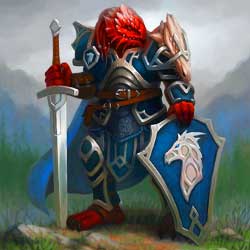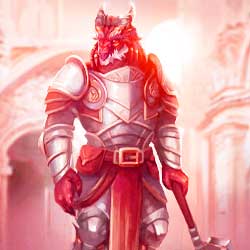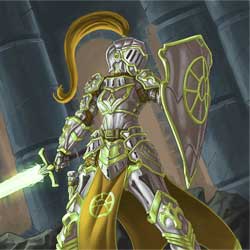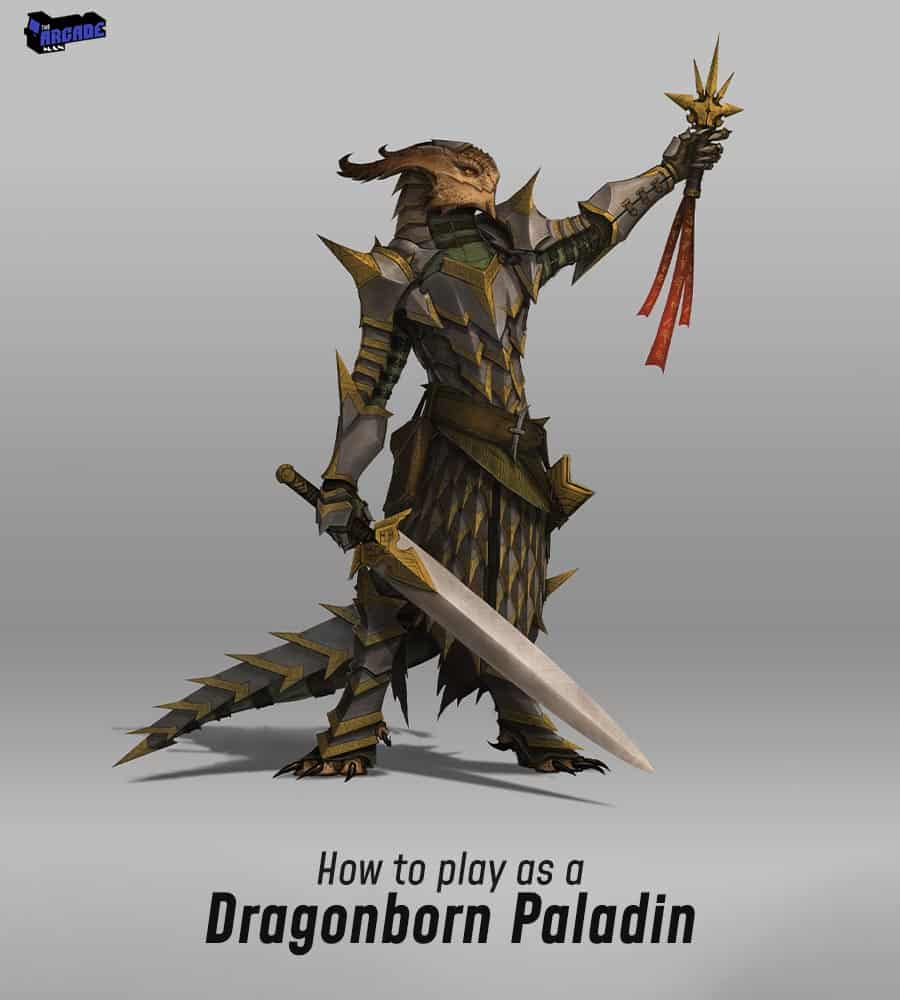Dragonborn Paladin 5E | D&D Dragonborn Paladin Guide

In Dungeons & Dragons 5e, the paladin is, without a doubt, one of the classes that are most enjoyable to play. It’s also likely the most independent class in the game, contributing much to the team in terms of utility, social skills, healing, damage output, and endurance.
They’re also a fairly challenging class to play, with a wide range of skills that interact with more discrete game features than any other character and demand careful resource management to avoid running out of power. Dragonborn, ironically, are designed to be Paladins.
The dragon gods of good and evil, Bahamut and Tiamat, are mentioned in the lore of DnD 5e, but the notion of a dragon being a good guy is at least mildly comical. I mean, they breathe fire; just look at them. It’s poetry to transform something as chaotic into a heroic law-abiding person. It has inspired me.
The goal here is to select the best combination of Dragonborn and Paladin characteristics for dishing out flaming and celestial punishment while tanking. A good offense is the best defense in combat.
This article will detail everything you need to know about playing with a Dragonborn Paladin in D&D 5e.
How to Make A Dragonborn Paladin
Dragonborn was initially produced from eggs as a distinct race, fusing the greatest characteristics of dragons and humanoids. They were either created by draconic gods or, according to some, dragons themselves.
Please note that Dragonborn is not a result of a dragon and human procreating and creating a hybrid race. Dragonborn is not that.
They are perfectly equipped for an adventurous existence because of their imposing look and draconic Strength, especially those who take on the role of the paladin. Mechanically speaking, the Dragonborn’s racial characteristics and inherent ability boost also mesh well with the Paladin class.
1. Ability Scores
Due to the paladin’s dismal ranged options, this class will be mostly focused on charging into battle with a blazing sword.
Strength and Constitution will thus be crucial to your build because they affect hit points, concentration saves, melee attack rolls, and damage. In terms of your capacity to cast spells, channel divine energy, and interact with others, Charisma is the cornerstone of any self-respecting Paladin.
Whatever method you use to generate your character’s ability scores while making a Dragonborn paladin, you should prioritize Strength and Charisma over Constitution. Because Wisdom is required for Perception checks, it is normally preferable to use it.
2. Dragonborn Racial Traits
The paladin and Dragonborn are naturally compatible in terms of racial characteristics and skills. Natural bonuses of +2 to Strength and +1 to Charisma are given to every Dragonborn.
Using the Standard Array technique, you can produce a Dragonborn paladin of the first Level with a value of 16 (+3) in Strength and Charisma.
All Dragonborn begins with the following characteristics in addition to the bonuses from your ability scores.
- Age: Dragonborn are able to walk shortly after hatching, grow to the size and development of a human child in their tenth year by the time they are three, and mature at the age of fifteen. They reach an average age of 80.
- Size: Most Dragonborn is taller than 6 feet and weighs, on average, 250 lbs. Your dress size is Medium.
- Speed: 30 feet per second
- Languages: Common and Draconic can be spoken, read, and written.
- Draconic Heritage: Your draconic ancestry is linked to one of the ten flavors of chromatic and metallic dragons, and it impacts your damage resistance and the nature of your breath weapon attack.
| Dragon | Damage Type | Dragon | Damage Type |
| Black | Acid | Green | Poison |
| Blue | Lightning | Red | Fire |
| Brass | Fire | Silver | Cold |
| Copper | Acid | White | Cold |
| Gold | Fire | Bronze | Lightning |
3. Breath Weapon
You have the ability to unhinge your jaw once during each short or long rest to release a powerful wave of energy. If you are a red Dragonborn, you breathe fire; if you are a white Dragonborn, you breathe ice; if you are a copper Dragonborn, you spit acid; and so on.
Any creature that is inside the radius of your breath weapon must attempt a saving throw or suffer 2d6 damage. The saving denominator is equal to 8 plus your Constitutional modifier plus your proficiency bonus.
Upon failing a save, a creature suffers 2d6 damage; upon succeeding, it suffers half as much damage. At level 6, level 11, and level 16, the damage goes up to 3d6, 4d6, and 5d6, respectively.
Although the breath weapon’s damage is a touch unimpressive, it’s a good way to do AoE damage to lower-level monsters like goblins and kobolds, which the paladin lacks.
Your draconic ancestry gives you an elemental damage resistance that reduces any incoming damage of the kind dealt by your ancestors’ breath weapon by half. This is the main advantage you get from being draconic.
Any frontline combatant can benefit from this powerful trait. Resistance to any damage type can be useful in a pinch, though choosing a damage type like fire or lightning will likely be more useful frequently.
4. Skills and Backgrounds
You can select two skills from the following categories when making a paladin: Athletics, Insight, Intimidation, Medicine, Persuasion, and Religion. Additionally, you are skilled at Charisma and Wisdom saving throws.
While the paladin is traditionally associated with talents like medicine and region, you’ll probably get the most use out of athletics and a charisma-based skill (like intimidation or persuasion).
Choosing the appropriate Background can be very beneficial when trying to improve other crucial talents like perception, history, or arcana. Each Background also grants you a little amount of additional narrative ability and aids in fleshing out your past, in addition to a variety of valuable talents, languages, proficiencies, and equipment.
Dragonborn 5e Explained
Feats
1. Master of Weapons

I’m not sure whether this class is for you—or if you’re capable of joy, for that matter—if the thought of slashing your adversaries with a massive flaming sword as they cower in awe before you doesn’t sound enticing.
You get to perform an additional melee weapon attack as a bonus action if you critically hit a monster with a two-handed weapon or bring it down to 0 HP. The attack’s damage roll can also be increased by +10 by accepting a -5 to-hit penalty.
2. Motivating Leader

The paladin’s Lay on Hands ability and general access to healing spells aren’t quite potent enough to fully fill the position of party healer if your group lacks a healer. Additionally, Divine Smite would benefit more from those spell slots.
Choosing the Inspiring Leader feat is one option to assist increase the survivability of your entire party and take advantage of your high Charisma modifier.
With this feat, you can spend ten minutes delivering a stirring speech that gives you up to six other nearby creatures temporary hit points equal to your Charisma modifier and your character level. The complete explanation of why the Inspiring Leader feat fails can be found here.
3. Master Sentinel/Polearm

Due to the fact that Polearm Master allows you can use your response to launch an opportunity attack against any enemies who are within the range of your melee weapon (if you’re using a Halberd, Glaive, or Pike, that’s 10ft), this is without a doubt one of the strongest feat combos in the game.
The Sentinel feat then reduces the speed of any adversary hit with an opportunity strike to 0 ft.
The basis of this combo is that an adversary can rush toward you, get hit hard on the head, and can no longer come near enough to attack you. Both feats also accomplish other useful tasks.
Subclasses
The Sacred Oath, a paladin, takes on at the third Level and serves as a major defining factor for all paladins, even Dragonborn paladins. Varied paladin pledges emphasize various factors, from pure damage output to potent auras and useful spellcasting.
In our Paladin Oath Ranking Guide, you can see a complete breakdown of all the sacred oaths that paladins can swear.
With fire, blood, and steel, paladins who vow an Oath of Vengeance are committed to righting some significant wrong. With the help of their Channel Divinity ability, Vow of Enmity, and strong single target spells like Bane and Hunter’s Mark, vengeance paladins can eliminate a single adversary from the battlefield by selecting them.
1. The Oath of Vengeance
As you apply the scared state to your enemies and cast higher-level spells like Banishment and Hold Monster, the Abjure Enemy feature, which can also be accessible through your Channel Divinity, lends you some battlefield control.
If you want to concentrate on consuming your opponents with holy fire from your lips and your magical abilities, select the Oath of Vengeance.
2. The Oath of the Ancients
If you’re seeking defensive prowess, the Oath of the Ancients provides you access to some of the best durability elements in the game. This oath is difficult to beat if your group wants a tank with a splash of druidic utility spells for good measure.
Your Aura of Warding grants resistance to all spell damage at level 7, extending to any allies within 10 feet of you (this benefit increases to 30 feet at level 18.
You can entangle an opponent in magical vines using your Nature’s Wrath Channel Divinity feature. You have access to a few excellent defensive spells from the druid list, like Stoneskin and Protection from Energy.
Fighting Styles 5e Dragonborn Paladin
At the second level, all paladins can select a fighting style that enhances their powers with a specific type of weapon.
If you want to make your Dragonborn paladin the best tank possible, select the Defense fighting style, which increases your AC while wearing armor by one. You can start the game with an AC of 19 if you combine this with chainmail and a shield at the first Level, making you almost unattackable.
Grab a big, two-handed weapon like the Greatsword and select Great Weapon Fighting, which allows you to reroll 1s and 2s on damage dice if you’re craving raw damage output.
The Longsword, Battleaxe, or Warhammer are all good choices if you wish to strike a balance between these two alternatives. When using a weapon in one hand while dueling, you will receive a flat +2 damage bonus. You continue to be able to utilize a shield with your other hand while receiving a constant damage bonus.
How to Play as A Dragonborn Paladin

As a Dragonborn, you benefit from your elemental breath and damage resistance to the same element. Other benefits and drawbacks are dependent on your draconic heritage.
As a Paladin, you gain the following benefits.
1. Skill Proficiencies
Pick two skills from Athletics, Insight, Intimidation, Medicine, Persuasion, and Religion.
2. Divine Sense
You have the ability to sense anything bad or magical around you by hearing, hearing, and smelling it. If a celestial, demon, or undead creature within 60 feet of you is not concealed by the absolute cover, you are aware of its location and kind.
You can also identify the presence of any consecrated or desecrated locations or objects within the same radial range, much like with the hallow spell.
3. Lay on Hands
Lay on Hands: You have the ability to heal anyone you come into contact with. You can even slap someone healthy. A total of hit points that are equal to your paladin level multiplied by five can be restored by you.
You can restore a number of health points to a creature by touching it as an action, up to the amount of power you still have left, by drawing energy from the healing pool.
This is ineffective against constructions and the undead.
4. Fighting Style
After reaching level 2, you can select one of the following.
- Defense
- Dueling
- Greater Weapon Fighting
- Protection
5. Divine Smite
When you hit a monster with a melee attack, summon your radiant divine power.
6. Divine Health
Congratulations on your Divine Health! You have access to health care and vaccinations (immunity to diseases).
7. Sacred Oaths
Level 3 unlocks Sacred Oaths, Oath Spells, and Channel Divinity. Regardless of the oath you choose, each one has its own set of unique spells that you can cast to produce magical effects.
Dragonborn experience a lot of discrimination or strange stares when it comes to getting along with other races because they are nearly unheard of. They have only been present in Toril for a few hundred years, making them a somewhat uncommon sight.
A half-elf or Cthulhu dancing to Dancing Queen is more likely to be encountered than this race. They praise those who excel and are skilled and are unbiased toward other races, but before turning to other people or even gods for help or assistance, they first ask a fellow Dragonborn.
| Sacred Oath | Level-Oath Spells |
| Oath of Devotion | 3rd Level – protection from evil and good, sanctuary 5th Level – lesser restoration, zone of truth 9th Level – beacon of hope, dispel magic 13th Level – freedom of movement, guardian of faith 17th Level – commune, flame strike |
| Channel Divinity | Sacred Weapon, Turn the Unholy |
| Oath of Ancients | 3rd Level – ensnaring strike, speak with animals 5th Level – moonbeam, misty step 9th Level – plant growth, protection from energy 13th Level – ice storm, stoneskin 17th Level – commune with nature, tree stride |
| Channel Divinity | Nature’s Wrath, Turn the Faithless |
| Oath of Vengeance | 3rd Level – bane, hunter’s mark 5th Level – hold person, misty step 9th Level – haste, protection from energy 13th Level – banishment, dimension door 17th Level – hold monster, scrying |
| Channel Divinity | Abjure Enemy, Vow of Enmity |
| Oath Breaker | 3rd Level – Hellish Rebuke, Inflict Wounds 5th Level – Crown of Madness, Darkness 9th Level – Animate Dead, Bestow Curse 13th Level – Blight, Confusion 17th Level – Contagion, Dominate Person |
| Channel Divinity | Control Undead, Dreadful Aspect |
Despite their outward look, Dragonborn is actually quite sensitive. No, not in a boo-hoo emotional way. Instead, they are endearing and sympathetic, which gives them an advantage in Charisma.
Despite this, Dragonborn is fiercely independent, self-sufficient, and rarely seeks help because they prefer to be looked up to than to depend on others. Yes, stubbornness comes with the territory, so you should never wager against one unless you’re ready to lose.
Conclusion
Despite the irony, D&D 5e Dragonborn makes ideal paladins because they can be strong fighters, have a bonus in Strength for heavy armor and the elemental breath, and are more likely to maintain their oath than break it.
You do not have to entirely or even adore the deity to whom you are in service, as being a paladin is for a variety of reasons- unless the pledge you sign is the road of Devotion. Dragonborn Paladins are a lot of fun to play and one of the most well-rounded subclasses in D&D 5e.






